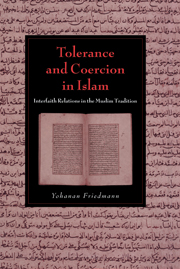Book contents
- Frontmatter
- Contents
- Preface
- Introduction
- 1 Religious diversity and hierarchy of religions
- 2 Classification of unbelievers
- 3 Is there no compulsion in religion?
- 4 Apostasy
- 5 Interfaith marriages
- 6 Concluding observations
- Selected Bibliography
- General Index
- Index of Qurʾānic verses
- Index of prophetic traditions
1 - Religious diversity and hierarchy of religions
Published online by Cambridge University Press: 10 August 2009
- Frontmatter
- Contents
- Preface
- Introduction
- 1 Religious diversity and hierarchy of religions
- 2 Classification of unbelievers
- 3 Is there no compulsion in religion?
- 4 Apostasy
- 5 Interfaith marriages
- 6 Concluding observations
- Selected Bibliography
- General Index
- Index of Qurʾānic verses
- Index of prophetic traditions
Summary
Since the earliest period of their history, Muslims have been conscious of the religious diversity of the human race and considered it a problem of importance. In an illuminating discussion, W. C. Smith has shown the unique attitude of Islam to the multiplicity of religions. Muslim tradition debated the nature of religious diversity since its inception and invested considerable effort in trying to understand its significance and the background for its development. Furthermore, classical Muslim literature reflects intense curiosity concerning the religious history of mankind, from the creation onward. Numerous verses of the Qurʾān express the idea that humanity had been united in faith during the primeval stages of its existence. For various reasons discussed in the tradition, dissension set in afterward, the primordial faith became corrupt and distinct religious communities came into being. Several verses of the Qurʾān are devoted to descriptions and appraisals of religions other than Islam. Qurʾānic exegesis, ḥadīth and jurisprudence have expanded the treatment of this topic and contain wide-ranging discussions of the religious traditions encountered by Muslims in the nascent stage of their history: idolatry, Judaism, Christianity, Zoroastrianism and Sabianism. A whole literary genre, known in Arabic as al-milal wa al-niḥal, developed since the eleventh century onward and include detailed treatment of Jewish, Christian and Muslim sects, as well as extensive descriptions of the religions and philosophies of Iran, India and Greece.
- Type
- Chapter
- Information
- Tolerance and Coercion in IslamInterfaith Relations in the Muslim Tradition, pp. 13 - 53Publisher: Cambridge University PressPrint publication year: 2003

